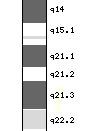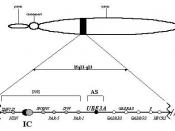Angelman syndrome, also called happy puppet syndrome, is a genetic disorder named after the doctor who first described it back in 1965. Angelman syndrome affects an estimated 1 in 10,000 to 20,000 people. The typical characteristics of a person with Angelman's syndrome include mental retardation, blond hair, pale, deep-set eyes, a long chin, a puppet-like gait, and an absurd laugh. This is where the nickname "happy puppet syndrome" is derived. (Angelman Syndrome)
There is one major cause of Angelman Syndrome. People normally have two copies of the UBE3A gene, one from each parent. Both copies of this gene are active in many of the body's tissues. In the brain, however, only the copy inherited from a person's mother (the maternal copy) is active. If the maternal copy is lost because of a chromosomal change or a gene mutation, a person will have no active copies of the UBE3A gene in their brain.
This loss of gene function likely causes many of the characteristic features of Angelman Syndrome. The UBE3A gene is located on chromosome 15. Most cases of Angelman Syndrome (about 70 percent) occur when a segment of maternal chromosome 15 containing this gene is deleted. In other cases (about 11 percent), Angelman Syndrome is caused by a mutation in the maternal copy of the UBE3A gene. The OCA2 gene is located on the segment of chromosome 15 that is often deleted in Angelman syndrome. A loss of this gene results in unusually light-colored hair and fair skin in some people with the condition. Since Angelman Syndrome it due to the alteration or deletion of chromosome 15, Angelman Syndrome occurs in males and females equally, and it affects all racial groups. (Angelman Syndrome)
The major common features of Angelman's syndrome, in addition to those already mentioned above,



Comment
Very informative. Great paper!
0 out of 0 people found this comment useful.